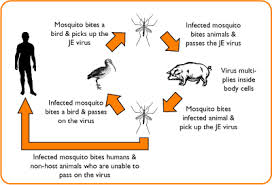Japanese encephalitis previously known as Japanese B encephalitis – is a disease caused by the Mosquito-Borne Japanese encephalitis virus. The Japanese encephalitis virus is a virus from the family Flaviviridae. JE virus is a zoonotic virus, which can be transmitted from animals to humans under certain conditions, though it is chiefly spread by mosquitoes. The JE virus is the most frequently documented cause of viral encephalitis in Asia. It has a high case-fatality rate (10-30%), and it is estimated that approximately 30,000 to 50,000 contract the JE virus each year in Asia, resulting in 10,000 to 15,000 deaths—mostly among children less than 15 years of age.
Transmission:
Domestic Pigs and wild Birds (herons) are reservoirs of the virus. The most important vectors of this disease are the mosquitoes Culex tritaeniorhynchus and Culex vishnui. This disease is most prevalent in Southeast Asia and East Asia.

Sign and Symptoms:
Japanese encephalitis has an incubation period of 5 to 15 days and the vast majority of infections are asymptomatic: only 1 in 250 infections develop into encephalitis.
01. Fever
02. Headache
03. Lifelong neurological defects ( deafness, paralysis)
04. and malaise
This may last for a period of between 1 and 6 days. Signs which develop during the acute encephalitic stage include neck rigidity, cachexia, hemi paresis, convulsions and a raised body temperature between 38–41 °C (100.4–105.8 °F). Mental retardation developed from this disease usually leads to coma.
Treatment:
There is no specific treatment for Japanese encephalitis and treatment is supportive; with assistance given for feeding, breathing or seizure control as required. Vaccination is the best way to prevent JE and its associated morbidity and mortality.
References
-Japanese encephalitis: Wikipedia
-Recent Out Break of JE virus : E- news
-International Centre for Diarrhoeal Disease Research, Bangladesh
 Vetsbd Livestock related only Bangla blog
Vetsbd Livestock related only Bangla blog

